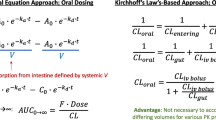Abstract
The purpose of this paper is to apply a physical law, described by the node equation, to certain aspects of renal and cardiovascular physiology. The well-known relations for filtration, secretion, and reabsorption, and mathematical expressions for flows, all of them examples of the dilution method, such as renal plasma flow, Fick's formula for cardiac output, and Kety's formula for cerebral blood flow, are easily and systematically derived.
The method of derivation requires the reduction of the physiological system under study to a flow diagram composed of branches and the points where they meet, which are called nodes. Once the appropriate node or nodes are chosen, the node equation can be applied to each of them and can be solved for the variable under study.
This treatment of the above-mentioned topics provides:
-
1.
a basic principle which represents a common stem for all of them;
-
2.
an improvement to the general understanding of the subjects;
-
3.
a tool which eventually may help in the design of new experiments.
Sommaire
Le but de cet article est d'appliquer une loi physique, telle que les équations de Kirchhoff, à certains aspects de la physiologie rénale et cardiovasculaire. On peut en déduire facilement et systématiquement: les relations bien connues de filtrage, de sécrétion, de réabsorption, ainsi que les expressions mathématiques des débits, qui sont toutes des exemples de la méthode de dilution; en particulier, la circulation du plasma dans le rein, la formule de Fick pour le débit cardiaque et la formule de Kety pour la circulation sanguine du cerveau.
La méthode de dérivation exige de réduire le système physiologique à étudier à un diagramme composé de diverses branches et de leurs points d'intersection, qui sont appelés des noeuds. Une fois le ou les noeuds choisis, l'équation de Kirchhoff peut être appliquée à chacun d'entre eux et être résolue pour les variables en question.
La méthode, appliquée aux sujets mentionnés ci-dessus, apporte:
-
1.
Une principe de base commun pour tous;
-
2.
Une amélioration de la compréhension générale des sujets;
-
3.
Un ontil qui peut éventuellement aider de nouvelles expériences.
Zusammenfassung
Der Zweck dieser Arbeit liegt in der Anwendung eines physikalischen Gesetzes, das in der Knotengleichung gegeben ist, auf gewisse Aspekte der Nieren- und Herzkreislaufphysiologie. Die bekannten Beziehungen für Filtration, Sekretion und Reabsorption, und die mathematischen Ausdrücke für Flußgrößen—alle sind Beispiele der Verdünnungsmethode—wie der renale Plasmafluß, die Ficksche Formel für die Herzleistung und die Ketysche Formel für den zerebralen Blutdurchfluß werden leicht und systematisch abgeleitet.
Die Methode der Ableitung erfordert eine Reduzierung des untersuchten physiologischen Systems auf ein Flußdiagramm, welches aus Verzweigungen besteht. Die Punkte, an denen diese zusammentreffen, werden als Knoten bezeichnet. Wenn der oder die geeigneten Knoten gewählt sind, kann die Knotengleichung auf jeden Knoten angewandt werden und für die gesuchten Variablen gelöst werden.
Die Behandlung der obengenannten Punkte liefert (1) ein Grundprinzip als gemeinsame Basis; (2) ein besseres Verständnis des Fachgebietes und (3) eine Möglichkeit zur Planung neuer Experimente.
Similar content being viewed by others
References
Attinger, E. O. (1964) Elements of theoretical hydrodynamics. In:Pulsatile Blood Flow, (edited byAttinger, E. O.), Chap. 2, pp. 15–76. McGraw-Hill, New York.
Fick, A. Über die Messung des Blutquantums in der Herzventrikeln.Verhandl. phys.-med. Ges. zu Würzburg, 1870, 36. Reprinted and translated byHoff, H. E. andScott, H. J. (1948), Physiology,New Engl. J. Med. 239, 120.
Kety, S. S. (1960) Theory of blood-tissue exchange and its application to measurement of blood flow. In:Methods in Medical Research (edited byBruner, H. D.), Vol. 8. Year Book Publishers, Chicago.
Kety, S. S. andSchmidt C. F. (1948) The nitrous oxide method for the quantitative determination of central blood flow in man: Theory, procedure, and normal values.J. clin. Invest. 27, 476.
Middendorf, W. H. (1965)Analysis of Electric Circuits. Wiley, New York.
Pitts, R. F. (1966).Physiology of the Kidney and Body Fluids. Year Book Publishers, Chicago.
Sokolnikoff, I. S. andRedheffer, R. M. (1958)Mathematics of Physics and Modern Engineering. McGraw-Hill, New York.
Author information
Authors and Affiliations
Rights and permissions
About this article
Cite this article
Valentinuzzi, M.E., Geddes, L.A., Baker, L.E. et al. The node equation and its applications in physiology. Med. & biol. Engng. 6, 387–397 (1968). https://doi.org/10.1007/BF02476060
Received:
Issue Date:
DOI: https://doi.org/10.1007/BF02476060




